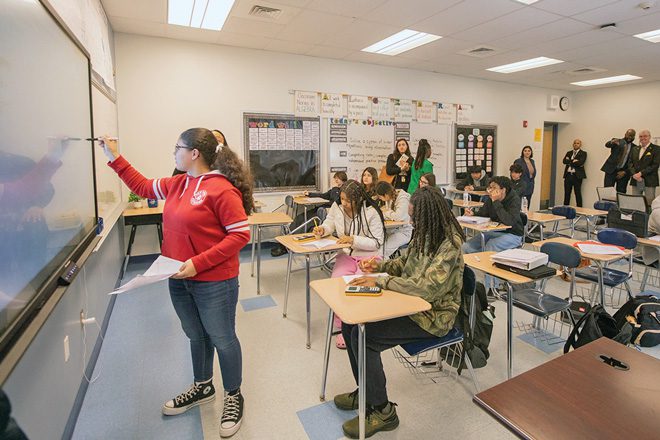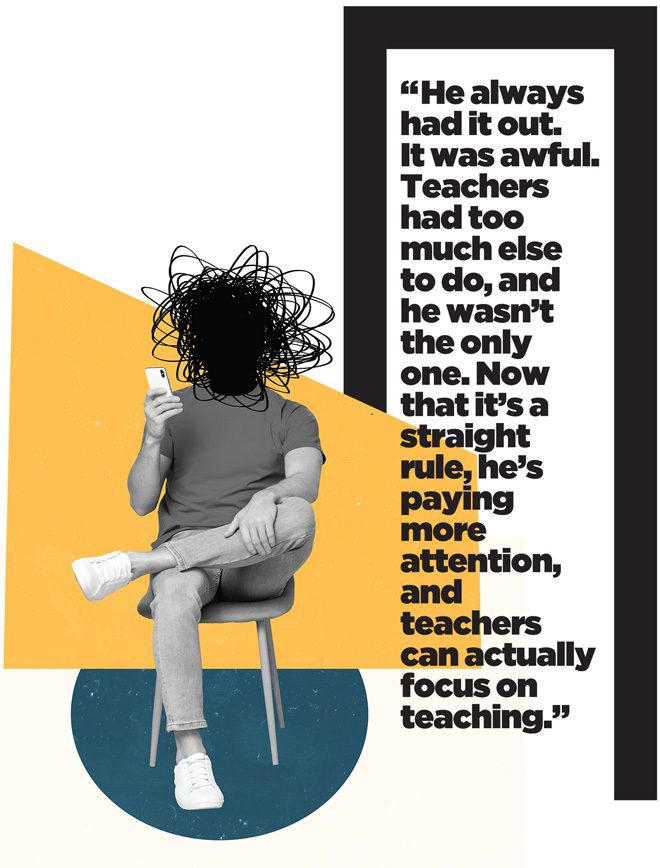Throughout the state, school districts are studying just how smart it might be to ban cell phones in school. (The Governor thinks it’s a genius idea, and he’s putting money behind that.) Here in South Jersey, several school districts have made the move to get students off their phones, some are just testing the waters, some are all in.
Josh Hammer remembers what it felt like to lose himself in his phone during class.
“It’s the endless scroll,” says the Cherry Hill East junior. “Instagram, TikTok – you can’t get to the bottom. I’d tell myself, ‘Just one more video,’ but then I’d just keep going. Even when I knew I had to pay attention, I’d get sucked in. And everyone else was doing it too.”
Like many students, Josh spent much of his school day distracted by his phone while teachers often tried unsuccessfully to keep kids engaged. But this year, things changed. Cherry Hill banned cell phones and other wireless devices during instructional time. No more scrolling under desks. No more buzzing notifications in the middle of a lesson. And for Josh, no constant temptation pulling away his attention.
Students store electronics in district-provided pouches during academic hours, then find one of 20 unlocking stations at the end of the day.
“I was always distracted before,” he admits. “My phone was always in my pocket, and I’d feel the urge to check it. Now it’s in my backpack, so I can actually focus and get my work done.”
Cherry Hill’s move to limit cell phone use in class mirrors a growing nationwide push to address what many see as a crisis of student distraction, mental health struggles and declining academic performance tied to excessive phone use. The issue has reached the Statehouse in Trenton, where Gov. Phil Murphy recently announced a $3 million allocation to help New Jersey’s 600 school districts implement cell phone bans in classrooms. Funds could be used to purchase things like lockable pouches for students to secure their devices during the school day.
“Unfortunately, as I can attest as a parent, in recent years, we have seen a new obstacle emerge when it comes to our children’s education: cell phones,” Murphy said during his State of the State address in January. “Today, our children are inundated with screens. And if you ask just about any educator, they will tell you that mobile devices are a distraction in the classroom. They are fueling a rise in cyberbullying. And they are making it incredibly difficult for our kids, not only to learn, but to retain the substance of what they learn.”
But while the issue is clear, the solution is more complicated.
For years, parents and teachers in Cherry Hill saw the same problem: students glued to their phones when they should have been learning – distracted not just by games and texts, but by the constant pull of social media. Posts, messages and group chats could spread instantly, fueling real-time drama, conflicts and bullying played out online and in the classroom.

“Students have become so accustomed to using their cellular devices that it was almost like an addictive type of force,” says Kwame Morton, Ed.D, superintendent of Cherry Hill schools. “If they heard a buzz or a ping – or even if they didn’t – they would check their phones. It was clear we had to do something.”
In collaboration with the PTA, teachers and students, Cherry Hill administrators considered 3 options: doing nothing, implementing a full phone ban or limiting phone use during class while allowing it at lunch, study hall and on buses. After surveying thousands, the third option gained overwhelming support.
“It was clear the community wanted us to protect instructional time,” says Morton. “We debated whether to use lockable devices or trust students to follow the policy. The students themselves asked, ‘Trust us to be responsible,’ and we listened.”
Under rules enacted in September, students must silence their phones, smartwatches and earbuds, and store them in backpacks or lockers during class. Teachers are responsible for enforcing this policy, and the district uses a progressive discipline system to ensure student compliance.
A first offense might result in a warning. Repeated violations could lead to lunch detention, after-school detention or, in more serious cases, Saturday detention.
What surprised administrators most was how smoothly the transition went.
“We thought there would be massive pushback, but we didn’t see that,” Morton says. “For the most part, students understood why we were doing it. Some even say they feel freer without their phones.”
 And while it’s too soon to measure the full academic impact, he says there’s been a noticeable drop in disciplinary issues tied to phones.
And while it’s too soon to measure the full academic impact, he says there’s been a noticeable drop in disciplinary issues tied to phones.
“Before, students would text things like, ‘Meet me at the B-wing bathroom,’ and then they’d leave class,” he says. “That led to discipline issues – cutting class, roaming the hallways. We’ve seen a dramatic decrease in those situations.”
For some, the ban has made a big difference.
“Before, I was always on my phone – playing games, texting, watching videos. And when everyone else around you is doing it, it’s impossible to stop,” says Josh. “Now? My phone is in my backpack, and I actually get my work done. I think it’s a good thing.”
One Cherry Hill father of three, who asked that his name not be published, says the policy’s impact has varied – two of his children adjusted easily. Still, for his son with attention challenges, it has been a game changer.
“He always had it out,” he says. “It was awful. Teachers had too much else to do, and he wasn’t the only one. Now that it’s a straight rule, he’s paying more attention, and teachers can actually focus on teaching.”
For East junior Joey Lieberson, it hasn’t been such a significant change, and she says enforcement has been spotty.
“For the first week, it was really strict,” Joey says. “But after that it got way more relaxed. In my AP classes, most students put their phones away anyway, but in my regular-level classes, teachers remind students once, and 5 minutes later, they’re back on their phones.”
Morton acknowledges there’s been some backslide. Some students still need reminders.
“That’s typical in schools,” he says. “But overall, we’re seeing positive results.”
Cherry Hill isn’t the only South Jersey school district addressing the issue. Policies on the books in Camden, Pennsauken and Gloucester City already enforce phone-free classrooms. At Woodbury Junior-Senior High School, where Murphy recently visited, a sign outside the school announces a cell-phone-free campus from 7:15 am until 2:37 pm. Students store electronics in district-provided pouches during academic hours, then find one of 20 unlocking stations at the end of the day.
The policy is stricter than Cherry Hill’s voluntary approach. During a discussion at Woodbury, Murphy and educators acknowledged parents’ initial concerns about being unable to reach their children. They noted that the school is staffed with security personnel and has emergency procedures in place for situations requiring immediate communication. Parents can also call the main office if they need to get a message to their child.
One student said her father doesn’t like the policy since he can’t reach her during the day, but she reminds him he can always call the school office. Another student commented that it’s a good thing that people can no longer block the hallways filming TikToks during the school day.
Studies have found that students in schools with strict phone bans tend to score higher on standardized tests, particularly lower-performing students. Research has also linked excessive screen time to increased anxiety, depression and sleep issues in teenagers, raising concerns about its long-term impact on mental health.
“There’s so much national attention now on the negative effects of phones in schools,” Morton adds. “As we see the results of overuse and misuse, there’s definitely a need to act – not just for academics, but for our children’s well-being.”















